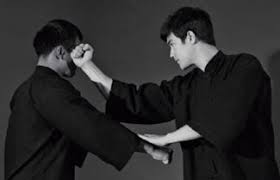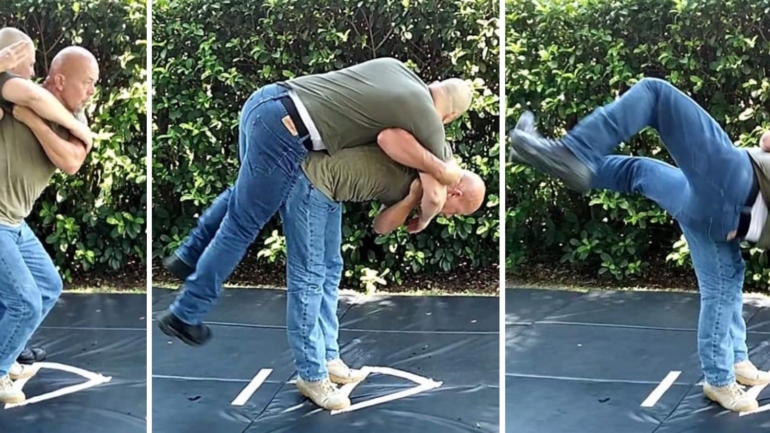I was in elementary school, the 6th grade, when I bought my very first martial arts book at the school book fair. It was called Junior Judo by E.J. Harrison. When I was in 7th grade, I bought my second martial arts book, Bruce Lee’s Fighting Method Vol. Two: Basic Training by Bruce Lee via mail order from an ad that ran in black belt Magazine. I still have them both. I honestly have to admit that the “Channeling my Inner Bruce Lee” articles have been the most fun ones that I have done. Doing judo out of Bruce Lee’s famous strong side forward stance and interjecting some of his concepts with my favorite Judo technique has just been a blast to play with on the mat. I also have to give a shout out to my black belt student, training partner, uke and friend Det. David Perrington for allowing me to play with these concepts.
One of the things Kano didn’t like as it pertained to sport judo was that it literally became a wrestling match! Judoka took stances like wrestlers and it was more reliant on strength and was contrary to his belief in maximum efficiency and minimum use of energy. Kano wrote how fighting bent over, in what he termed as a “western wrestling-style,” exhibited poor posture and balance and was vulnerable to attack. He also noted how stiff arms and the use of strength slowed a judoka’s reactions and ability to move quickly. Kano wanted judoka to stand upright, in the style of a “western boxer! To remain relaxed in this posture so that they could move more fluidly in attack and defense.
As stated in Part one of this series, The Jeet Kune Do that Bruce Lee developed contained elements of Wing Chun, along with boxing, fencing, and other martial arts. He used all of these to create a unique approach to combat which incorporated a fighting posture from which the individual could be the most relaxed in and could move the most efficiently from. Both Kano and Lee were visionaries, innovators and their approaches coincide with what every athlete knows today, that a stiff muscle is a slow muscle and a relaxed muscle offers faster action and reaction.
Trapping involves fighting in close quarters and is a key aspect of Jeet Kune Do. JKD Trapping has shown to include practical self defense techniques like head-butts, knees, elbows, and eye-gouges. Trapping techniques allows you to quickly take out an attacker regardless of their size or strength. Judo also works much the same way in that a smaller person can throw a bigger attacker. In Judo. all fighting is done at extremely close range, a JKD trapping range.
Bruce Lee’s personal art of trapping was highly effective. It involved disrupting and breaking down the opponent’s structure. He would corrupt his opponents balance, posture and timing. This is yet another similar concept that JKD has with judo grip fighting. Bruce Lee was excellent at using his body’s inner structure and mechanical advantages to trap and strike with maximum speed, power and accuracy. The word I like to use is ballistic!
Lead Hand Parry to lead hand straight punch to Split Step Entry Ippon Seoi Nage
The lead leg split step entry Ippon Seoi Nage I look at much like that of a jab in boxing or in JKD the lead straight punch. It is more linear in execution and harder to counter and evade than the conventional step pivot Ippon Seoi Nage. With proper foot work and explosive movement you can cover distance and get under your opponent quickly.

1.) Blue is in a Jeet Kune Do strong side forward position (On Guard), white has taken a boxer’s stance. 2.) White throws a left hand straight punch. Blue parries the punch to the inside with his right hand. 3.) From the point of contact with the parry and without any initial draw back, Blue delivers a right straight punch (commonly referred to in JKD as the Straight Lead).

4.) As the right hand punch retracts, 5.) pivoting clock wise on both feet punch in your grip with the left hand and drive off the heel of your left foot, striking the pocket of the opponent’s shoulder. The impact of punching in your grip should be hard enough to rock the opponent on his heels. 6.) Grab the jacket at the area struck and pull with the left hand bringing your left elbow up high. As you begin to pull with the left hand keeping your knees bent and stayijng low bring the left foot up toward the lead foot turning counter clockwise. Important note: Keep the knees bent when entering into the throw. Your belt line should alswy be lower than his belt line!

7.) As the rear foot comes up the lead foot moves deep between the opponent’s feet. The outside of your right leg should be touching the inside of his right leg. As both feet touch the mat the toes of both feet should be pointing toward your front, directly in front of you and in the direction of your throw. Both knees are bent and Your belt line is lower than his belt line. 8.) The left foot steps back and straighten your legs out popping your hips upward lifting the opponent off the mat. To finish the throw twist your upper body by bringing your right elbow toward your left knee.
When it comes to Bruce Lee’s trapping concepts and how they can be incorporated in judo and Judo grip fighting there is a lot more going on than opening a line of attack or tying up the opponent’s arms just to punch. Not only did it allow for opportunities to punch it opened a gateway to execute a judo throw or take down. Bruce Lee’s trapping method disrupted and broke down the opponent’s structure, a key strategic point. It corrupted the opponent’s balance, posture, froze his timing, and sent shock into the opponent’s body like electricity through copper wire.
By virtue of his technique, he was able to automatically measure the correct distance for optimal striking power and accuracy, the kind needed for deep penetration to attack the opponent’s body. In Trapping Lee re-angled his attack to open new lines of attack, which in turn created more opportunities to execute a technique. He took away the distance that the opponent needed to be effective in their counter attack. And to make all of this work, he depended on a good athletic position giving him the easiest possible way to move, proper mechanics, a variety of carefully forged tools…..in the case of this article Judo’s Ippon Seoi Nage.
Flowing from one technique to the another separates the superior from the mediocre. It also is this “flowing” of athletic movement that distinguishes and even dictates the out come. If anything using this principle as a drill concept is a fun and excellent way to develop hand speed, eye hand coordination, reflex action as well parrying and gripping speed.
Objectives of Trapping (Reasons to Trap)

- To limit your opponent’s offensive potential
- To set up your major tools (a big shot)
- To create space for a hit (referring to both physical space and also timing)
- To change the Attribute Set (to favor a trained Martial Artist)
- To use your opponent’s energy against them
- You’ll end up there anyway so might as well look dope doing it! LOL!
Pak Sao to Back Fist to Split Step Entry Ippon Seoi Nage
Think of the rear-hand as the goalie on your soccer team. If your goalie is really good, the other team is going to have a rough time trying to score. In JKD, the back hand’s primary responsibility is to play goalie, not try and score. The rear-hand can guard either flank easily, using pak-sao. You can go on the offense with the rear hand when it comes to creating an opening and opportunity and setting up a throw.

1.) Blue is in a Jeet Kune Do strong side forward position (On Guard), white has taken a right lead boxer’s stance . 2.) White starts to throw a right lead straight punch. 3.) Blue parries the punch down with his left hand and shuffles forward closing distance on the opponent. Blues right hand back fist begins to travel over the top of white’s parried hand.

4.) Blue connects with the right back fist to the opponent’s side of face. 5.) Pivoting on both feet clockwise and lowering his center of gravity Blue punches in his left hand and gripping the opponent at the front of his opponent’s arm pit. 6.) Blue pulls his opponent forward with his left hand as he brings his left foot up toward his right foot. His right foot begins to travel between the opponent’s feet. Blue right arm begins to move under the opponent’s right arm.

7.) As the rear foot comes up the lead foot moves deep between the opponent’s feet. The outside of your right leg should be touching the inside of his right leg. As both feet touch the mat the toes of both feet should be pointing toward your front, directly in front of you and in the direction of your throw. Both knees are bent and Your belt line is lower than his belt line. 8.) The left foot steps back and straighten your legs out popping your hips upward lifting the opponent off the mat. To finish the throw twist your upper body by bringing your right elbow toward your left knee.
Judo Grip fighting and Jeet Kune Do: Way of the Intercepting Grip
 “A Stop-Hit is a timed hit made against the adversary at the same time he is making an attack. It ANTICIPATES AND INTERCEPTS the final line of attack and is delivered in such a way that the executant is covered, either by being in line behind the hit or by supplementary covering. To ensure success, it must have correct anticipation and timing, plus precise placement.” -Bruce Lee
“A Stop-Hit is a timed hit made against the adversary at the same time he is making an attack. It ANTICIPATES AND INTERCEPTS the final line of attack and is delivered in such a way that the executant is covered, either by being in line behind the hit or by supplementary covering. To ensure success, it must have correct anticipation and timing, plus precise placement.” -Bruce Lee
Jeet Kune Do is known as the Way Of The Intercepting Fist, which means we need to know have a deep understanding of the the timing to attack or strike. This principle has applications in all striking, grappling and self defense. JKD eliminates unnecessary movements for economy and efficiency. The “Timed Hit” in JKD is an interception of a incoming punch. The Timed Hit simultaneously shuts down the line of attack which in this instance will be the opponent’s grip attempt.
JKD Interception with rear hand to Split Step Ippon Seoi Nage
Generally the lead hand is the attacking hand. You want to cheat distance by getting the attacking hand closer to your target to cut the distance the hand has to travel down. The rear hand is typically the defensive hand used to parry in coming grip attempts but as mentioned earlier the hands can switch roles. The rear hand can be used offensively and the lead hand defensively. It is a matter of exercising tactics and strategy.

1.) Blue is in a Jeet Kune Do strong side forward position (On Guard), white is fighting out of a right side forward posture. 2.) White attempts to get a grip on blue’s left lapel with his right hand. 3.) Blue punches in his grip intercepting the opponent’s grip attempt by brushing over the top of the opponent’s right arm deflecting it off line slightly and gets his grip.

4.) Blue pulls his opponent forward with his left hand as he brings his left foot up toward his right foot. His right foot begins to travel between the opponent’s feet. Blue right arm begins to move under the opponent’s right arm. 5.) As the rear foot comes up the lead foot moves deep between the opponent’s feet. The outside of your right leg should be touching the inside of his right leg. As both feet touch the mat the toes of both feet should be pointing toward your front, directly in front of you and in the direction of your throw. Both knees are bent and Your belt line is lower than his belt line. 6.) The left foot steps back between the opponent’s feet.

7.) and 8.) Straighten your legs popping your hips upward lifting the opponent off the mat. 9.) To finish the throw twist your upper body by bringing your right elbow toward your left knee.
“Carlson Gracie Winter Haven’s openness to judo is primarily due to Barron Shepherd’s passion to ensure judo is adapted and utilized for their BJJ students. I have traveled all over Central Florida, and while most BJJ and MMA locations seem to discredit judo, (and the overall effectiveness of adapting judo gripping strategies), Barron and his team at Carlson Gracie are the minority that truly understand the value of what judo can bring. There are many common misconceptions about the effectiveness of judo, however, it is eye opening to see individuals like Barron and his Carlson Gracie Team continue the legacy of judo and display its relevancy in the world of martial arts. Thank you to Barron and Carlson Gracie Winter Haven for ensuring that judo lives on and adapts for the BJJ community to access as well. As judo and BJJ evolves, I see minorities like this becoming pioneers not only in BJJ and judo, but in the overall spectrum of mixed martial arts.” – Lauren Meece, 2000 Judo Olympian, Coach, Scouter and Trainer, US National Champion, Pan Am Bronze medalist, 9th place at Judo World Championships



